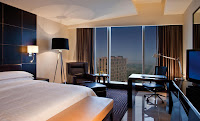Remember
when you were trying to find some information about your future holiday? “Where
am I going to stay? Is the hotel perfect?” Before the World Wide Web was
invented, people were using the word-of-mouth, but that changed with the
development of the internet. In special, the increase in social media selection
and online bookings has made word-of-mouth much more efficient and noticeable.
(Viglia et al., 2016)
Since
the booming of the social media, including blogs, networks, chat rooms, online
reviews, and user-generated websites, has become the major component of
consumers’ marketing and communication decisions. The information social media
has about their users is extensive, allowing companies to develop targeted
marketing programs on social media. Many travel sites, such as TripAdvisor and
Expedia, contain an impressive number of users’ ratings of travel products,
made to ease the customer information searching. Even though a traveller does
not personally know the users that were posting, they view these reviews as
being reliable, and that is because those people have tried the product
(Lodging Interactive, 2015).
Bowen
(2015) talks about how millennials, people born between the late 1970s and
mid-1990s, have taken over the travelling market as they are the generation
that lives life through social media. They shared their memories, their
thoughts, and also their encounters and based on that TripAdvisor has offered
the possibility for them to share their experience in a particular restaurant
or hotel. In the same time, with the vast opportunity of being fully informed
about an individual product comes a higher risk of misinterpretation.
Burn-Callander (2016) talks about how TripAdvisor reviews, made anonymously are
affecting one in five organisations, which have to pay as much as £30,000 to
put right. As the majority of review are subjective, the perception of the
restaurant or the hotel can be deteriorated. With almost 230 user contributions
per minute, the image of a business can change in seconds (Smith, 2016). In his article, Starmer-Smith (2016), discuss the significant
impact that negative reviews, which can be made using fake accounts, can affect
a small business with a few visitors. From food poisoning to racist comments,
many restaurants and hotels faced false complaints posted on TripAdvisor.
Reference
list
Bowen, J., (2015) "Trends affecting
social media: implications for practitioners and researchers", Worldwide
Hospitality and Tourism Themes, Vol. 7 Iss: 3, pp.221 – 228
Burn-Callander, R. (2016). Bad reviews and
online 'trolls' cost UK businesses up to £30,000 a year. Available at
www.telegraph.co.uk/finance/businessclub/11635195/Bad-reviews-and-online-trolls-cost-UK-businesses-up-to-30000-a-year.html
(Accessed 12 Dec. 2016).
Lodging Interactive (2015),
“Lodging interactive expands reputation management
and social media marketing to restaurants”, available at: www.hospitalitynet.org/news/4069404.html (accessed 12 December 2016).
Smith, C. (2016). 23 Amazing TripAdvisor
Statistics. DMR. Available at:
http://expandedramblings.com/index.php/tripadvisor-statistics/ (Accessed 12
Dec. 2016).
Starmer-Smith,
C. (2016). Tripadvisor reviews: can we trust them?. [online]
Telegraph.co.uk. Available at:
http://www.telegraph.co.uk/travel/hotels/8050127/Tripadvisor-reviews-can-we-trust-them.html
(Accessed 12 Dec. 2016).
Viglia,
G., Minazzi, R., Buhalis, D., (2016),"The influence of e-word-of-mouth on
hotel occupancy rate", International Journal of Contemporary Hospitality
Management, Vol. 28 Iss 9 pp. 2035 - 2051
twitter.com/tripadvisor




